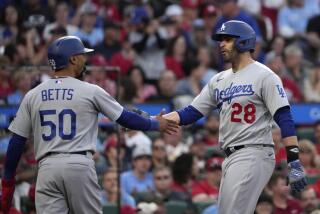Moving On : A Touch of Sadness Accompanies Ryan, Brett as They Leave Together
- Share via
The years go by in a hurry. Every winter, when it’s time to shovel the snow, the driveway gets a little longer. Every summer, when it’s time to mow the grass, the lawn gets a little larger.
A little girl’s trip from pigtails to prom dress occurs in a blink. Wasn’t it yesterday when that little boy was pedaling around on a tricycle? Now he’s borrowing the car keys.
Yesterday, you were young and so were baseball’s stars. Yesterday, DiMaggio and Williams owned the outfield. Yesterday, Mays and Mantle succeeded them.
Yesterday, Nolan Ryan and George Brett were just beginning. On Sunday, they are finishing.
There’s a touch of sadness about Ryan and Brett leaving baseball together.
“They leave us with two less players that people of our generation can identify with,” said sports psychologist Thomas Tutko of San Jose State University. “The gap between the diehard fan and the current players just grows greater.”
It was Satchel Paige who offered a philosophy for the ages when he said, “Don’t look back, something might be gaining on you.” In baseball, though, the past grows more distant, diminished when players of this magnitude leave the game.
Remember yesterday.
Remember a raw, young right-hander throwing 90 m.p.h. fastballs with very little idea where they will wind up. Remember the scared kid brother of a journeyman pitcher, trying to make it as a third baseman.
They arrived in times of turmoil--Ryan in 1968, perhaps the most tumultuous summer in the history of American politics, Brett in 1973, when the seeds were planted for a presidency in crisis.
Vietnam. Woodstock. Nixon. Watergate. Those were the places, the names and the events that dominated those days. Those were the things that concerned the national psyche--not Ryan and Brett, two young guys trying to figure out this mysterious business of playing big league baseball.
Ryan was 21 in 1968, a shy, rawboned Texan, with a slow, pleasant drawl, hidden in the recesses of a talented New York Mets pitching staff. The headliners were Seaver, Koosman and McGraw. The also-ran was Ryan, a kid in the bullpen who was equipped with three speeds--fast, faster and fastest--but very little control. He was a curiosity, dipping his finger in pickle brine, using trainer Gus Mauch’s old wives’ remedy to toughen the skin and prevent blisters.
By 1972, the Mets had run out of patience waiting for Ryan to garner his enormous potential. They traded him--and four other players--for Jim Fregosi, one in a series of failed experiments to solve their perpetual third base problem.
The next year, 1973, Brett showed up in Kansas City. He was 20 then, a baseball brat, who tagged after his big league brother, falling in love with the life, hoping that somehow he could stick around. He’d ride the team bus when Ken Brett was pitching for Boston, getting the feel of what it was like to be a major leaguer.
Some day, he thought. Some day.
For the next two decades, as the demonstrators grew up, as the disgraced president became an elder statesman, as Woodstock became just another little town in upstate New York, and the war became a dim, dark memory, Ryan and Brett were stars.
They moved into extraordinary statistical territory--more than 320 victories and well over 5,700 strikeouts for Ryan; better than 3,150 hits and 315-plus home runs for Brett. They were special members of a baseball pantheon.
More than the hits and no-hitters, they represented a genre.
“They came from a time of loyalty and hard work, of burning desire to succeed,” Tutko said. “You don’t see that anymore. Now we have glitter and glitz instead of guts. I hate to see these people go. It’s like a little part of me is going with them.”
And the rest of us, too.
It is the end of an era, and for a whole generation of fans, the driveway just got a little longer and the lawn a little larger.
More to Read
Go beyond the scoreboard
Get the latest on L.A.'s teams in the daily Sports Report newsletter.
You may occasionally receive promotional content from the Los Angeles Times.










